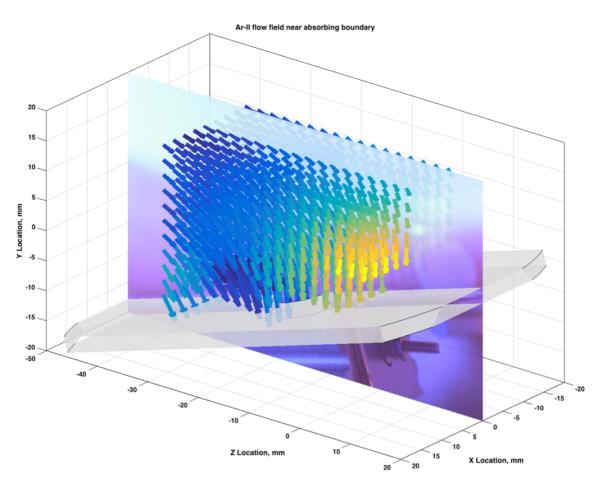Scientists measure how ions bombard fusion device walls

Measured flow field of ions in a plasma overlaid on visual image of the system. Credit: West Virginia University
For the first time, researchers at West Virginia University (WVU) have directly measured the complicated 3D patterns of flowing plasma as it strikes the walls of fusion and space propulsion devices.
Understanding how this process occurs, and how scientists and engineers can prevent it, is critical to the development of the next generation of energy and space exploration technologies. The measurements performed at WVU in a “helicon” plasma are the first ever 3D ion flow fields mapped in a volume.
The measurements show how plasmas in fusion tokamak devices and Hall thruster spacecraft engines accelerate parallel to the wall prior to impact. This causes the walls of these devices to erode more rapidly than previously thought, limiting their lifetimes. This flow is surprising because it is not predicted in theoretical models. The researchers are currently investigating the reasons for this behavior, looking at aspects of the plasma that were assumed to be unimportant in previous models.
These results, including the first fully 3D flow measurements (Figure 1), will be presented at the 2016 American Physical Society – Division of Plasma Physics meeting in San Jose, Oct. 31 to Nov. 4.
“These measurements have already yielded surprising insights into plasma behavior near walls,” said Derek Thompson, who took the measurements with Miguel Hernandez and Umair Siddiqui in the research laboratory of Earl Scime at West Virginia University.
###
Contact:
U. Siddiqui
908-752-1314
sid.umair@gmail.com
Abstract TP10.00084
Comparison of 3D ion velocity distribution measurements and models in the vicinity of an absorbing boundary oriented obliquely to a magnetic field
Thursday, November 3, 2016, Room: Exhibit Hall 1
Media Contact
All latest news from the category: Physics and Astronomy
This area deals with the fundamental laws and building blocks of nature and how they interact, the properties and the behavior of matter, and research into space and time and their structures.
innovations-report provides in-depth reports and articles on subjects such as astrophysics, laser technologies, nuclear, quantum, particle and solid-state physics, nanotechnologies, planetary research and findings (Mars, Venus) and developments related to the Hubble Telescope.
Newest articles

Recovering phosphorus from sewage sludge ash
Chemical and heat treatment of sewage sludge can recover phosphorus in a process that could help address the problem of diminishing supplies of phosphorus ores. Valuable supplies of phosphorus could…

Efficient, sustainable and cost-effective hybrid energy storage system for modern power grids
EU project HyFlow: Over three years of research, the consortium of the EU project HyFlow has successfully developed a highly efficient, sustainable, and cost-effective hybrid energy storage system (HESS) that…

After 25 years, researchers uncover genetic cause of rare neurological disease
Some families call it a trial of faith. Others just call it a curse. The progressive neurological disease known as spinocerebellar ataxia 4 (SCA4) is a rare condition, but its…





















